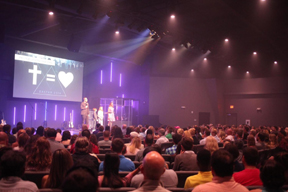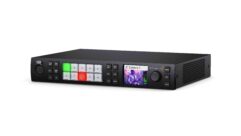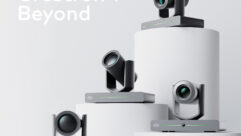
SVC Podcast – Show Notes – Show 155-1
In this edition of the SVC Podcast, SVC Contributing Editor Bennett Liles talks with Ben Graham of Crown Design Group, a church AV integrator in Bradenton, Florida, about the sound, projection and lighting installation done in the new building for Coastlife Church. Ben outlines the lighting part of the project done with Elation and ETC instruments along with a Jands Vista lighting controller. He discusses the best approach to use for church AV work and the way the lighting equipment was installed.
For Part 2
Links of interest:
- Crown Design Group, church AV integrator in Bradenton, Florida
- ETC Source Four Junior ellipsoidal lighting fixtures
- Elation Color Pendant lighting fixtures
- Jands Vista M1 lighting controller used at FOH
- Doug Fleenor Preset 10 Architectural lighting control wall panel
- Doug Fleenor Entry Station Two lighting controller used as a remote for the Preset 10
Download Podcast Here:
https://s3.amazonaws.com/nb-svc/public/public/155-1_Crown_Design_Group_G…
From Sound & Video Contractor Magazine, this is the SVC Podcast with Ben Graham of Crown Design Group. Show notes for the podcast are on the web site of Sound & Video Contractor Magazine at svconline.com.
Coastlife Church in Venice, Florida recently added a new 500-seat auditorium and they had it completely outfitted with projection, sound and lighting by Crown Design Group. Everything had to be set up to support lots of live music. Ben Graham is here to give us the story on the lighting phase of the project, coming up next on the SVC Podcast.
Ben, it’s nice to have you here with us on the SVC Podcast from Crown Design Group. The one we’re going to be talking about today was a big church installation with audio, projection and lighting and the lighting is what you’re going to be telling us about. You put in all new Elation lighting gear. But first, let’s hear about Crown Design Group. What’s been going on there?
Well, it’s good to be here. Thanks for having us on. Crown Design is the company that my partner and I started just about four years ago. We’re actually in a town called Bradenton, Florida. It’s just north of Sarasota. Everyone says Bradenton/Sarasota, so it’s kind of that same area. We’re a beach town down in good old sunny Florida; a great place to live. There’s a lot of retirement people here, but it’s kind of starting to blow up and boom around this area. So I mean we stay busy just in this area. It’s pretty crazy. We’re a one-stop shop, we like to call it, for our clients when it comes to anything AVL-related whatsoever. We love to get in early with them and kind of dream with them from the very, very beginning and help them come up with some type of concept. A lot of times they just have a budget. They don’t really know how to use the money or what to buy or how to make it all work. So we like to sit down with them and kind of have a dream session with them and then walk them through maybe a concept. Then we get into a full design phase with them where we can do full drawings and renderings and everything else to give them a good visual of kind of what the end result would be. And then we kind of just manage the whole project with them. We work with the G.C. or subcontractors if it’s a new build. We manage the money and their budgets and everything. They purchase everything through us. We’ve set up a lot of relationships with manufacturers so we buy direct from everybody and we can save people money on all that stuff. And then we go into the full install. So we do the install as well and then all the way into the programming, and then even all the way into training volunteers or staff at their companies or whatever who are going to be using the equipment. And then we even offer like a support after the fact if they want to do that, where we can be available via phone or whatever to help them with problems that they may have with the equipment. So that’s kind of what we do. We work with a lot of churches. We grew up in the church and we’re very involved in our church, and we really, really know that world. We know the kind of equipment that works well for churches, and so 70-80 percent of our business is churches. [Timestamp: 3:06]
Well, that’s a pretty good setup when you can get in right from the planning stage and they entrust everything to you. At least you’re coordinated that way instead of having to take bits and pieces where they say, “We want this equipment but then we want you to pick out everything else.” This way works a lot better.
Yeah, it does. Most of us were actually on staff at a very large church and we oversaw the productions for it before we were doing this full time. So that’s a great resume to have. Honestly, we’ve been really blessed and we’ve had a lot of work over the past couple of years. We worked with a lot of different churches and we really have learned the right equipment to do specific things especially in the church world. Churches especially like that and they like the trust factor with that. We’re not going in as crazy salesmen to them. It’s really just another part of kind of what we do is we want to help them out as well. So we want them to have the best-case scenario for their AVL situation. [Timestamp: 3:59]
And the Coastlife Church must be fairly contemporary with live music and all that goes with it.
Yep. They’re a younger church, younger congregation, and very high energy, modern worship service so it’s not your typical pews and carpet kind of room. It looks more like a club, really – blacked out ceilings and concrete floors, like stained concrete floors. Just a totally different look. They have a full band, probably 12 people on stage. Basically a full band and a lot of vocals and stuff like that. And full AVL production setup for every service. It’s a live production. [Timestamp: 4:39]
Yeah, they’re maxing out the sound, the lighting, the video and everything so you have to do a pretty heavy duty job for them.
Yeah, and it was great coming in really early with them. I’m glad they contacted us early. A lot of times churches don’t really think through that. They’ll build their building and then they say oh, we need sound and lights and video. So they’ll come to us after the fact and it turns into a big mess. So we like to try to educate people too as well. If they’re going to go into a project, try to get an AVL integrator – whoever that is – to kind of be involved from the beginning so you can use their expertise on what you should do from day one; making sure there’s conduit everywhere you need it, making sure there’s power, making sure there’s infrastructure for future stuff that they want to do that you can only do from day one when they’re pouring the slab. So we were able to do that with them and set them up great for day one and also for the future. They want to do IMAG in their eventually, so all of that infrastructure is in place there to do that. Had they not worked with an integrator, they probably would not have thought through that or done that, which obviously causes problems in the future when you want to start adding things. [Timestamp: 5:47]
And I’m sure they appreciate the fact that they can call you up if they run into trouble. You know how everything is installed so the continuity between the first planning all the way through to support at the end must be great for them.
It is, and we like to have a great relationship with them. We want them to be a client for life with us, so it is a relationship as well with us and we want to help them whenever they have issues and we want to train them properly so that they can function. There’s nothing worse than having a company come in and you drop however many hundreds of thousands of dollars to set up your room and then your volunteers can’t run it and your services don’t go well and everything else. So that’s a big part of what we do as well. We want to make sure they’re set up and they’re trained properly and they can function and have services. Garrett and I actually go to at least the first service in the new building. The first couple of services we’re usually there with them, with the volunteers during the services so they can have great first services and be confident in what they’re doing. So yeah, that’s a big part of what we do as well. [Timestamp: 6:47]
And Garrett is, of course, your partner in the business who we’ll be talking to in Part 2.
Yep. Absolutely.
Yeah, you guys did a big job on lighting in addition to sound and video so describe the lighting job that you spec’d and installed for them.
It’s like a stage lighting setup. We put in lighting bars for their front white light. They do need it for like the message time. They want a great white wash across the stage, but again they need individual spots that they can illuminate at certain times for their worship service. So we used Source Four’s ellipsoidals. Actually we used the Source Four juniors – the zooms. You don’t have to worry about lenses that way. It’s a lot easier and they can move them around and rehang them simply if they need to. And then just some Source Four washes as well. Then we supplement with some more LED’s just for color to wash the front of the stage. There was a runoff of Leviton dimmers that we had installed in a dimming room. And then we gave them eight different moving fixtures, some profile movers and then some wash movers. And then they actually had some LED tape, I mean these digital tube things that they had that we helped hook up and give them kind of like a backdrop just for like a look. But I would say the biggest wow for the lighting was actually the house lighting, which is becoming really popular for us. We do a lot of it. It’s becoming a lot more affordable and churches are sick of having to get out scaffolding or ladders or whatever to go up and change all the lamps and their old lights that they have in their room. They’re super-hot and they make the AC run harder and everything else. So people are wanting to know some options on switching out the LED. So we have been using these Elation Color Pendants quite often. They’re a great fixture, very affordable, individual DMX control on every one of them. RGBW so you can mimic a normal-looking white light. You can get that cold, modern look in white light if you want, but you can mimic a normal discharge light that looks just like a nice, warm white wash in your room. I think Elation did great on it. They wash very, very soft. You never see a hotspot whatsoever. Obviously that has to do with the layout and the grid and your ceiling height and everything else, but we have no complaints on them. They do have a wireless DMX built in, but we don’t use it in a permanent installation. We hardwire everything DMX just so it’s 100 percent go, especially if it’s a house light. But especially for the more modern, contemporary churches, it adds such an element to their worship service because most of them use the big video screens and they have moving backgrounds and everything else on these screens. They usually have a color for each song or whatever, and so now instead of just dimming the lights, if the color of the song is purple on the screens then they can change their whole room to purple and then the next song comes and it’s blue, they can change their whole room to blue. It’s a huge environmental change as well as just overall getting rid of conventional lighting that costs a lot of money to run and creates tons of heat and you either turn it on or off. [Timestamp: 9:57]
Incredible mood setter, once you get all of it coordinated, that’s a lot of stuff to get working together. I was going to ask you why you went with the Elation fixtures – price, reputation, features? It sounds like all three.
Yeah. We really don’t have any complaints other than the wireless DMX, which is probably okay, but in a permanent situation we just feel like I’d rather have a hard wire going to it just because it’s a house light and you don’t want to kind of depend on a wireless system. It actually works on a 2.4 system, which is what Wi-Fi works on. So if you were to pack a church out with a thousand people and everybody’s on their phone on the Wi-Fi, then the channels could get pretty heavy and then you might drop a light or something like that every once in a while. So that’s the only reason we didn’t go with that. Other than that, we love the fixtures. Like I said, we do them a ton. We have bought and sold a ton of them and honestly we have not had a single issue with any of them up to this day. So over the past year we have not even had a single issue with one of the fixtures. [Timestamp: 10:58]
Where is the lighting control point located?
The control is back in the front-of-house booth and we used Jands Vista for control. It’s a pretty simple setup. We’ve found that it works great with volunteers; very volunteer-friendly. It’s very visual so you can see all your fixtures very easily and if you lay it out and you set it up properly it’s very easy for a volunteer to sit down and click through a song and hit all the cues. It’s a two-universe setup, so we’re going out one universe and actually running through a bunch of Doug Fleenor wall panels and then going to a splitter before we go out to all the house lights. And then the other universe is going out to the stage to control the bars and the other LED’s and stuff that are one stage. [Timestamp: 11:42]
I was going to ask you about the Doug Fleenor wall panels, too. How was it putting those up and getting them placed right?
They’re pretty solid for what they do. It’s not a software, it’s a hardware piece. Once you get them in place and you get them set up and you kind of know how to set up the jumpers in the air and make sure all the settings are correct. They work great. Again, they’re affordable and they are pretty rock-solid when it comes to reliability, but the way we used it in this scenario is pretty cool. They have a front lobby in this building and they wanted, or needed, separate control in that room at the same time they were having control in the main room so when they walk into the lobby they can turn the lights on without it affecting what’s going on in the room. And so you can do that with the Doug Fleenor panel if you set it up properly. They give you that versatility to be a little creative with it. And then obviously as soon as the Jands Vista lighting computer is turned on, the wall panels are deactivated so someone can’t walk up and bump a panel during service and turn all the lights on or turn all the lights off or whatever. They’re only active when the computer is off, which makes it easy for when cleaning people come in they can just come in a push a button and they have lights. They don’t have to worry about trying to go up and turn on the lighting board or the computer or whatever. [Timestamp: 13:02]
That’s great, especially in a church environment, not needing to have a bunch of experts there all the time.
Right. Right.
Sounds like that worked out and in Part 2 we’ll be talking with Garrett about the sound and video and how they do that. I know there’s plenty of it at this church. The lighting was a big job and I appreciate your telling us about it.
Thanks for having me on and I appreciate it.
Thank you for being here with us for the SVC Podcast with Ben Graham. Show notes are on the website of Sound & Video Contractor Magazine at svconline.com. Be back with us next week for Part 2 when we’ll have Ben’s partner at Crown Design Group, Garrett Walker. That’s on the next SVC Podcast.










